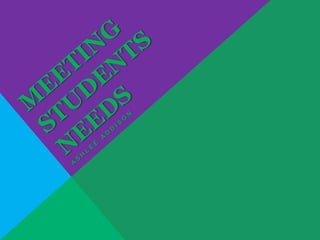Assistive Technology Presentation
•Descargar como PPTX, PDF•
0 recomendaciones•111 vistas
Denunciar
Compartir
Denunciar
Compartir

Recomendados
Más contenido relacionado
La actualidad más candente
La actualidad más candente (19)
Guiding Principles in the Selection and Use of Instructional Materials

Guiding Principles in the Selection and Use of Instructional Materials
Best practice in the classroom: Teaching Young Learners - Kylie Malinowska

Best practice in the classroom: Teaching Young Learners - Kylie Malinowska
Module 7.apt. 502.teaching and distance education 1

Module 7.apt. 502.teaching and distance education 1
Destacado
Destacado (16)
Similar a Assistive Technology Presentation
Teaching Enrichment Series: Incoporating Universal Design - Handouts

Teaching Enrichment Series: Incoporating Universal Design - HandoutsCenter for Teaching & Learning - University of Minnesota
Similar a Assistive Technology Presentation (20)
Teaching Enrichment Series: Incoporating Universal Design - Handouts

Teaching Enrichment Series: Incoporating Universal Design - Handouts
Training workshop for teachers on participatory teaching methods

Training workshop for teachers on participatory teaching methods
Contemporary teaching strategies powerpoint by lian

Contemporary teaching strategies powerpoint by lian
Writing Learning Material and Textbook Level PhD (1).pptx

Writing Learning Material and Textbook Level PhD (1).pptx
Chapter 9_Programme Teaching and Learning Strategies.pptx

Chapter 9_Programme Teaching and Learning Strategies.pptx
Universal Design for Learning (Inclusive Education)(UDL).pptx

Universal Design for Learning (Inclusive Education)(UDL).pptx
Differentiating Instruction Through The Implementation of UDL

Differentiating Instruction Through The Implementation of UDL
INTEGRATION OF INNOVATIE TEACHING PRACTICES IN TEACHING AND LEARNING PROCESS

INTEGRATION OF INNOVATIE TEACHING PRACTICES IN TEACHING AND LEARNING PROCESS
Último
Making communications land - Are they received and understood as intended? webinar
Thursday 2 May 2024
A joint webinar created by the APM Enabling Change and APM People Interest Networks, this is the third of our three part series on Making Communications Land.
presented by
Ian Cribbes, Director, IMC&T Ltd
@cribbesheet
The link to the write up page and resources of this webinar:
https://www.apm.org.uk/news/making-communications-land-are-they-received-and-understood-as-intended-webinar/
Content description:
How do we ensure that what we have communicated was received and understood as we intended and how do we course correct if it has not.Making communications land - Are they received and understood as intended? we...

Making communications land - Are they received and understood as intended? we...Association for Project Management
Último (20)
Unit-IV; Professional Sales Representative (PSR).pptx

Unit-IV; Professional Sales Representative (PSR).pptx
Unit-V; Pricing (Pharma Marketing Management).pptx

Unit-V; Pricing (Pharma Marketing Management).pptx
Vishram Singh - Textbook of Anatomy Upper Limb and Thorax.. Volume 1 (1).pdf

Vishram Singh - Textbook of Anatomy Upper Limb and Thorax.. Volume 1 (1).pdf
Making communications land - Are they received and understood as intended? we...

Making communications land - Are they received and understood as intended? we...
Mixin Classes in Odoo 17 How to Extend Models Using Mixin Classes

Mixin Classes in Odoo 17 How to Extend Models Using Mixin Classes
Food safety_Challenges food safety laboratories_.pdf

Food safety_Challenges food safety laboratories_.pdf
Python Notes for mca i year students osmania university.docx

Python Notes for mca i year students osmania university.docx
Basic Civil Engineering first year Notes- Chapter 4 Building.pptx

Basic Civil Engineering first year Notes- Chapter 4 Building.pptx
Jual Obat Aborsi Hongkong ( Asli No.1 ) 085657271886 Obat Penggugur Kandungan...

Jual Obat Aborsi Hongkong ( Asli No.1 ) 085657271886 Obat Penggugur Kandungan...
On National Teacher Day, meet the 2024-25 Kenan Fellows

On National Teacher Day, meet the 2024-25 Kenan Fellows
Assistive Technology Presentation
- 2. OVERVIEW Teaching is not an exact science, where one approach fits all. A carefully planned lesson might inspire one student to craft an amazing story, commit to improving her grades, and go on to college to become a journalist. That same lesson might leave another child confused and discouraged. Effective teaching requires flexibility and creativity. As special educators or as general educators, we must constantly ‘monitor and adjust’ our teaching techniques. The next few slides provide strategies for teaching students with disabilities.
- 4. INCLUSIVE PRACTICES Inclusion is the belief amongst community that it is their responsibility to educate all students so they reach their potential How to incorporate inclusive practices : Incorporate diversity into your overall curriculum. Be intentional about creating a safe learning environment by utilizing ground rules. Be proactive in connecting with and learning about your students. Utilize a variety of teaching strategies, activities, and assignments that will accommodate the needs of students with diverse learning styles, abilities, backgrounds, and experiences
- 5. UNIVERSAL DESIGN FOR LEARNING Universal Design for Learning Principles Multiple Means of Representation: To give learners various ways to acquiring information and knowledge Multiple Means of Expression: To provide learners with alternatives for demonstrating what they know, and rehearsing Multiple Means of Engagement: To tap into learners interest. Offer appropriate challenges, and increase motivation
- 6. DIFFERENTIATED INSTRUCTION A process to teaching and learning for students of differing abilities in the same class. The intent of differentiating instruction is to maximize each student's growth and individual success by meeting each student where he or she is and assisting in the learning process. Implementing based on: Content: What teacher plans to teach Process: How teacher 1. Plans instruction 2. Whole class Groups/pairs Product: Assessment of Content
- 7. EVIDENCE BASED PRACTICES Make decisions about what to teach their students Determine how effective the teaching/learning process has been based on data collected Direct instruction – effective in helping students learn to read through a fast paced, highly structured series of lessons
- 8. ASSISTIVE TECHNOLOGY Devices and services that improve the functional capabilities of students with disabilities Devices that can be utilized in the classroom Hearing loop (induction loop) NVDA Free Screen Reader Audible Books App Word Processing Provide copies of structured outlines Flow charts, task analysis, and networking ideas